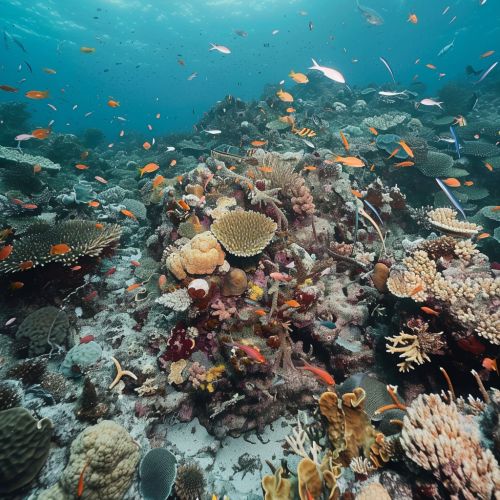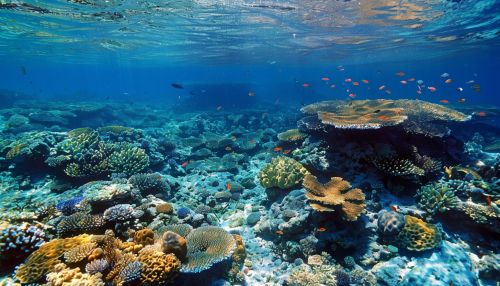Seamounts
Introduction
A seamount is an underwater mountain formed by volcanic activity. These geological features are typically found rising from the ocean floor, often reaching heights of several thousand meters. Seamounts are significant both ecologically and geologically, providing unique habitats for marine life and offering insights into the Earth's volcanic processes.
Formation and Geology
Seamounts are primarily formed through volcanic activity. They are typically created by the movement of tectonic plates over a hotspot, a location where magma from the mantle reaches the Earth's crust. As the tectonic plate moves, the hotspot remains stationary, creating a chain of seamounts over time. This process is similar to the formation of the Hawaiian Islands.
Seamounts can also form at mid-ocean ridges, where tectonic plates are diverging, and magma rises to fill the gap, creating new oceanic crust. Additionally, seamounts can form at subduction zones, where one tectonic plate is forced under another, leading to volcanic activity.
The composition of seamounts is primarily basaltic, a type of rock that forms from the rapid cooling of low-viscosity lava. Over time, seamounts can become extinct volcanoes and may be eroded by ocean currents, sometimes forming guyots, which are flat-topped seamounts.
Ecological Significance
Seamounts are biodiversity hotspots, providing habitats for a wide range of marine organisms. The complex topography of seamounts creates varied environments, including rocky outcrops, crevices, and sediment-covered slopes, which support diverse biological communities.
One of the key ecological roles of seamounts is their function as stepping stones for the dispersal of marine species. Many species use seamounts as waypoints during their migrations, and the unique habitats provided by seamounts support endemic species that are not found elsewhere.
The strong currents around seamounts bring nutrient-rich waters from the deep ocean to the surface, promoting high primary productivity. This upwelling supports large populations of plankton, which in turn attract larger predators, including fish, sharks, and marine mammals.
Biological Communities
The biological communities on seamounts are often highly specialized and adapted to the unique conditions found there. Common inhabitants include corals, sponges, and various species of fish. Deep-sea corals, in particular, are abundant on seamounts and can form extensive reef structures.
Seamounts also support commercially important fish species, such as orange roughy and alfonsino, which are often targeted by deep-sea fisheries. However, the slow growth rates and late maturity of many seamount species make them vulnerable to overfishing.


Geological Research
Seamounts are of great interest to geologists and oceanographers because they provide valuable information about the Earth's volcanic and tectonic processes. By studying seamounts, scientists can gain insights into the history of volcanic activity, the movement of tectonic plates, and the formation of oceanic crust.
Seamounts are also important for understanding the processes of seafloor spreading and plate tectonics. The age and composition of seamounts can be used to trace the movement of tectonic plates over geological time scales.
Conservation and Management
The unique ecological and geological characteristics of seamounts make them important targets for conservation efforts. Many seamount ecosystems are threatened by human activities, including deep-sea fishing, mining, and climate change.
Conservation strategies for seamounts often focus on establishing marine protected areas (MPAs) to limit the impact of fishing and other extractive activities. International agreements, such as the Convention on Biological Diversity (CBD), also play a role in promoting the conservation of seamounts and their associated biodiversity.
